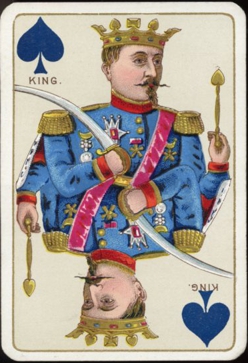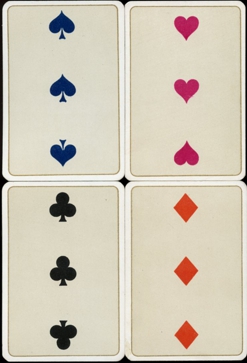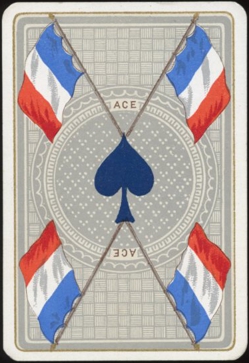|
|
|
March 2024 |
 |
|
It
had been standing on my desk for a while now, a pile of 7 decks, all
with different versions of the same deck. I had won this lot in the
previous Dominic Winter auction, so they came from the Dudley Ollis
collection.
We had never owned any of them. It had been somewhere in the lower
regions of our wish list. That had a reason. On eBay we found out that
there were at least 2 versions of this deck and we found one of them
much more attractive than the other, but rather difficult to find too. Now that I have a number of
different versions, I choose to show that more attractive one here, but
the other versions will get some attention too. The enlarged portrait is
to illustrate the fine chromolithographic printing of this version. |
This deck
is known as Kimberley's Royal National Patriotic Playing Cards. It was the title
which William Kimberley, who created and published it, gave to this deck. The
suits represent different countries, powerful in the late 19th century. Spades
represent France, Hearts the U.S.A., Clubs Germany and Diamonds the U.K. The
portraits on the courts are recognizable, a bit stiff in my opinion, and
some of the depicted historical figures have been changed during the different
editions.
According
to the WOPC site the shown cards here are from the second edition, but this
isn't the only source used. Thanks to John Sings I received 2 EPCS Newsletter
articles by Trevor Denning about this deck too. And of course Dudley had made
his own notes about each deck, but it seems that he had followed Trevor
Denning's categorization in different types, from A to D.
The first EPCS article by Denning dates from May 1984. The second article is
from May 1992 and is more elaborate than the first, as new editions had been
found since 1984. Based on them Trevor Denning came to distinguish 5 different
editions and 4 types. This confirmed that the Deck of the Month here is a type A and from the
second edition. The following table of the different editions is based on
Denning's description "for quick means of identifying". I've added the
used printing techniques and the Type B, C and D decks can be seen by clicking the
letter there.
| Edition |
|
Date |
Type |
| 1 |
Printed in chromolithography (11
colours), giant central suit on the pips, numbers 2 - 10 written in full
in the corner. |
1892 -
c1893 |
A |
| 2 |
As above, but with conventional arrangement of the pips, no numbers. Both type A decks
contain gold in the printing. |
c1893 -
c1897 |
A |
| 3 |
Printed in crude offset, cloud
backgrounds on the aces of hearts, clubs and spades, with 4 flags on
each. Colours restricted to 3 and muddy, no gold. |
c1898 |
B |
| 4 |
Printed in photoengraved lithography, designs
changed and flags reduced to two on each ace. King, Queen, Jack and Ace are
still written in full. |
c1899 -
1901 |
C |
| 5 |
Printed in photoengraved lithography, but
instead of king, queen etc with conventional indices and numbers
throughout the deck.* |
c1902 -
1905 |
D |
| |
* c1902 with small indices and numbers
of 3 mm. Later larger: 7 mm. |
|
|
Three
additional remarks:
Trevor Denning illustrated his 1992 article with some cards from different editions. He
also showed the joker, but didn't mention anywhere when it entered these decks. As
I've only found the joker in type D decks, it's safe to assume that this was
around 1902.
Both Trevor Denning and the WOPC site describe in detail the 4 different suit
colours, used in the type A decks, but neither uses the term no-revoke for this
deck, which is the applicable term.
An article can only describe situations or items up to the moment it's written.
Afterwards those may change. Apparently Dudley Ollis came across some different
versions of the type D deck after 1992, which are in fact a 6th and 7th edition.
You'll find them under D in the table.
As
said, the deck was created by William Kimberley, who was one of the sons of the
David Kimberley & Sons company, maker of carpenters' planes in Birmingham
since around 1880. William applied for the patent, nr. 2388, on February 8,
1892. Production of the first edition probably started not long after, possibly mid
1892. On the box David Kimberley & Sons are formally mentioned as
publisher.
From the different styles and printing qualities of all the editions Denning
concludes that there must have been different printers too and there's something
to be said for that point. He mentions James Patrick, a printer from Holloway
Head who married William's cousin Emily. Together with others James Patrick
combined with William to form the Kimberley Press Ltd. in 1898. The company went
out of business in 1906, but is almost certainly responsible for the editions 4
and 5, introducing the completely redesigned type C and D decks. The printers of
the type A and B remain unknown.
However, a definite timeframe has been set. No decks from before 1892, date of
the patent, or later than 1906, end of the Kimberley Press Ltd.
Of
the courts only the kings and queens represent historical figures. They are not
all contemporary, so not a help to date the deck (see bottom of the page). The
jacks in the type A decks represent sailors from the navy of that suit's
country. This changed in the Type C (and D) edition, when the courts were
completely redesigned.
Well,
after this long intro, finally........ the cards.
 |
 |
 |
| (Louis) Napoleon
III |
Eugenie Marie de
Guzman, wife of Napoleon III |
|
| George
Washington |
Martha Washington |
|
 |
 |
 |
 |
 |
 |
| Emperor William I |
Empress consort,
princes Augusta |
|
| Albert, Prince
consort. |
Queen Victoria |
|
 |
 |
 |
|
Our deck consists of
52 cards and came without the original box. The "no revoke",
illustrated by 4 pip cards. |
 |

|

|
|
Thanks to the WOPC
site: pip cards from the first edition. Probably players for some reason
didn't like them, so they were possibly soon replaced by the
conventional pip cards. Hence the rarity of the first edition decks. |
|

|
|
One
last remark about the dating. The above table is the best tool to date the
different types and editions of this deck. I agree with Trevor Denning that,
when decks have been produced in different versions over years or decades, they
are often dated by the first edition. However, in this case you'll often find
the year 1897 as date in reference books. Here's an example from the Fournier
catalogue vol. I: |
|

|
|
Denning blames
Catherine Hargrave for this and
having read her description, I can agree with him. In her "A History of
Playing Cards", which was originally published in 1930, she doesn't give
that date directly, but she relates the deck with Goodall's Queen Victoria's
Diamond Jubilee deck from 1897 by describing it as a "much more modest and
less elaborate pack for the same purpose". But as she doesn't show any card from
her deck, we'll never know which version she had to compare. The Fournier Museum
shows a picture of the queen of clubs from the Type A deck. Not
mentioned in the text are the remarkable pip cards, so the museum
probably has the same edition as I show here. And when you've read the
intro above, you'll probably see some other flaws in the description
too. |
BACK
TO PRESENT MONTH





















